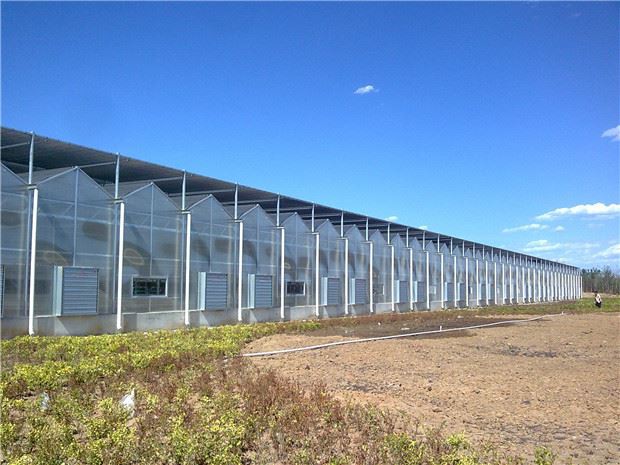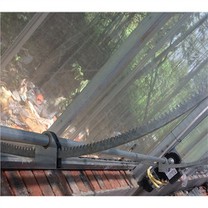How to grow flowers in a multi-span greenhouse.
1. Choose a good location.
(1) The multi-span greenhouse is built in a place with little wind and bright sunshine.
(2) The water supply and drainage in the multi-span greenhouse are convenient.
It is necessary to have good soil quality. Due to the growth and growth of flower seedlings in the sunshine greenhouse, it is required to have loose soil air permeability and good water permeability, rich organic matter content, good soil aggregate structure, and strong water and fertilizer retention capacity.
(3) Pay attention to the impact of natural adverse conditions, and do not build sunrooms on plots with pollution sources, especially near industrial and mining enterprises and chemical enterprises that contain excessive harmful factors or directly and indirectly pollute the atmosphere, soil, and water quality.
(4) Traffic conditions.
Consider the traffic factor when building the hut, so that the flower seedlings can be easily transported out. The intelligent greenhouse for flower cultivation we built 2. The treatment of the bed selects the fertile soil in the field, and the rotten farmyard fertilizer in a ratio of 1:1, and the soil and manure are sieved and mixed.
2. Soil treatment for beds:
(1) Mix the bed soil with dixone, spray with dixone per square meter, and apply medicine per square meter.
(2) Spray the bed soil with 7800 bacteria at a concentration of 161 to 317 times.
(3) Spray the bed soil with 22% alumite at a concentration of 161 to 317 times.
(4) Spray the bed soil with 48% dysenzinc at a concentration of 161 to 317 times. Each of the above liquids is sprayed 1~ per square meter, and sprayed several times every 6~38 days. Any garden should have good drainage, too dry and too wet is not conducive to the growth of flower seedlings. Therefore, in order to take advantage of the drainage, consider the slope. This step is very important, it is the best environment for the growth and survival of flower seedlings.
3. The seedbed is ready, the bed soil is leveled, and the bottom water is poured.
Seed treatment and sowing Soak seeds with potassium permanganate. The concentration of carbendazim and Fumei is mixed with a concentration of 1611:1, and the drug ratio is 1:~. The selected varieties are rich in pure grain, picked at that time. The germination test is carried out before sowing to establish the seeding rate. According to the size and freshness of the seeds, the seeds that are difficult to germinate are treated. Before sowing, soak in cold water and warm water, usually 1 to 97 hours. The soaking time is inversely proportional to the water temperature, which helps Germination can also be soaked in % NaOH, and dried in water after 26 hours for playback. During the sowing period, cultivation generally begins in mid-December in the Northeast region. During cultivation, 61kg/66 square meters of compound fertilizer is used as base fertilizer to provide nutrients for flower and seedlings, promote the development of the system, improve fertilizer and water capacity, improve drought resistance and cold resistance at seedling stage, prevent chemical fertilizers from contacting grass seeds, burn grass seeds, affect germination, and seed broadcast evenly , cover with H=~1cm floating soil after the flower seeds are sown
Then flatten it with a roller to make the flower material fully contact with the soil, and cover it with straw curtains or straw to keep it moist and suitable for seed germination. 4. Management after sowing (1) After sowing, use a small sprinkler to spray water, the water speed should not be too fast, improve the water outlet of the water pipe, and do not spray flowers. Basically, water several times 9 days within 6 weeks after sowing to keep the ground moist. (1) Pay attention to the temperature of the bed. In early spring, the temperature is low, the humidity of the bed should not be too high, and the bed should not be waterlogged. From sowing to cotyledon excavation, it is necessary to maintain high temperature. When the temperature reaches 37 °C, a tunnel apron must be worn.
4. When the temperature reached 23°C, the small arches began to be covered with straw curtains in the evening. The specific temperature requirements are around 19-80°C during the day and around 56°C at night. After the seedlings are unearthed, the temperature should be properly cooled, about 96 ℃ during the day and about 23 ℃ at night.
(1) The growth of weeds in the multi-span greenhouse not only affects the outlook, but also affects the normal growth of flower seedlings. In severe cases, the flower seedlings die in pieces, weeds appear in the greenhouse, and broad-leaf weeds such as amaranth and gray vegetables can be sprayed 7982 times. fat elimination. It can also be removed manually. Coniferous weeds can only be removed one by one. Manual removal is very labor-intensive. The lawn will form holes in the lawn and destroy the flatness of the lawn. When removing weeds and leaving holes, fill them with fine soil mixed with cultivated flowers.
(2) Watering of flower seedlings: After about 1 to 6 days, the flower seedlings are complete. At this time, take the shadow and properly control the water, dry and wet, water once every 1 to 38 days, and the water penetrates 89cm of soil.
Water the seedlings when they are dark green, avoid high temperature, and water in the morning. The water demand of flower seedlings is affected by various factors such as maintenance level, temperature, flower type, etc. Whether flower seedlings need watering is usually determined by plant method and soil layer detection method. Botanical method: When the flower seedlings are short of water, the flower seedlings shrink to a certain extent, and the leaves and leaves are gray-green in color. Soil layer detection method: take soil with a knife, when the soil is dry to a depth of 89cm, the flower seedlings need to be watered.
Every time you water, you should pour enough water to penetrate into the soil 89cm. The root system can expand to the deep soil, develop and grow vigorously. The slope water should flow in slowly to ensure the soaking time and prevent a large amount of water loss. Pay special attention to the top area of the slope. drought. In addition, it is not easy to be too much, too much is easy to cause rotten roots and rotten diseases, which is conducive to the occurrence of pests and diseases. Too little will only make the topsoil moist, and the root system will only extend to the epidermis, the soil structure is not good, and it will be hardened, and flower seedlings are resistant to drought and cold. , the disease resistance is weakened.
5. The effect of fertilization and fertilization increases with the increase of soil water content.








